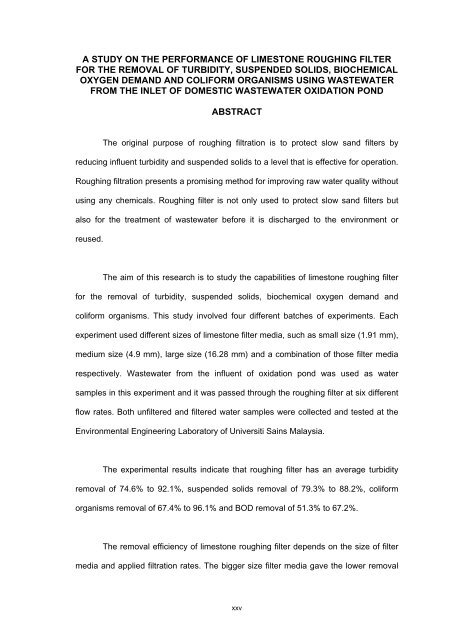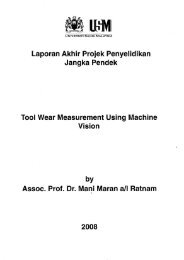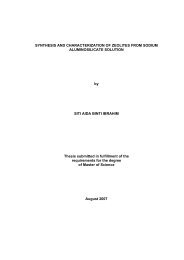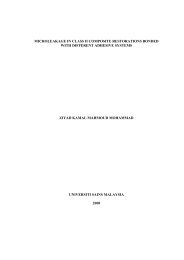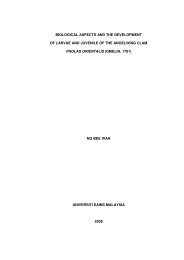a study on the performance of limestone roughing filter - ePrints@USM
a study on the performance of limestone roughing filter - ePrints@USM
a study on the performance of limestone roughing filter - ePrints@USM
You also want an ePaper? Increase the reach of your titles
YUMPU automatically turns print PDFs into web optimized ePapers that Google loves.
A STUDY ON THE PERFORMANCE OF LIMESTONE ROUGHING FILTER<br />
FOR THE REMOVAL OF TURBIDITY, SUSPENDED SOLIDS, BIOCHEMICAL<br />
OXYGEN DEMAND AND COLIFORM ORGANISMS USING WASTEWATER<br />
FROM THE INLET OF DOMESTIC WASTEWATER OXIDATION POND<br />
ABSTRACT<br />
The original purpose <strong>of</strong> <strong>roughing</strong> filtrati<strong>on</strong> is to protect slow sand <strong>filter</strong>s by<br />
reducing influent turbidity and suspended solids to a level that is effective for operati<strong>on</strong>.<br />
Roughing filtrati<strong>on</strong> presents a promising method for improving raw water quality without<br />
using any chemicals. Roughing <strong>filter</strong> is not <strong>on</strong>ly used to protect slow sand <strong>filter</strong>s but<br />
also for <strong>the</strong> treatment <strong>of</strong> wastewater before it is discharged to <strong>the</strong> envir<strong>on</strong>ment or<br />
reused.<br />
The aim <strong>of</strong> this research is to <str<strong>on</strong>g>study</str<strong>on</strong>g> <strong>the</strong> capabilities <strong>of</strong> limest<strong>on</strong>e <strong>roughing</strong> <strong>filter</strong><br />
for <strong>the</strong> removal <strong>of</strong> turbidity, suspended solids, biochemical oxygen demand and<br />
coliform organisms. This <str<strong>on</strong>g>study</str<strong>on</strong>g> involved four different batches <strong>of</strong> experiments. Each<br />
experiment used different sizes <strong>of</strong> limest<strong>on</strong>e <strong>filter</strong> media, such as small size (1.91 mm),<br />
medium size (4.9 mm), large size (16.28 mm) and a combinati<strong>on</strong> <strong>of</strong> those <strong>filter</strong> media<br />
respectively. Wastewater from <strong>the</strong> influent <strong>of</strong> oxidati<strong>on</strong> p<strong>on</strong>d was used as water<br />
samples in this experiment and it was passed through <strong>the</strong> <strong>roughing</strong> <strong>filter</strong> at six different<br />
flow rates. Both un<strong>filter</strong>ed and <strong>filter</strong>ed water samples were collected and tested at <strong>the</strong><br />
Envir<strong>on</strong>mental Engineering Laboratory <strong>of</strong> Universiti Sains Malaysia.<br />
The experimental results indicate that <strong>roughing</strong> <strong>filter</strong> has an average turbidity<br />
removal <strong>of</strong> 74.6% to 92.1%, suspended solids removal <strong>of</strong> 79.3% to 88.2%, coliform<br />
organisms removal <strong>of</strong> 67.4% to 96.1% and BOD removal <strong>of</strong> 51.3% to 67.2%.<br />
The removal efficiency <strong>of</strong> limest<strong>on</strong>e <strong>roughing</strong> <strong>filter</strong> depends <strong>on</strong> <strong>the</strong> size <strong>of</strong> <strong>filter</strong><br />
media and applied filtrati<strong>on</strong> rates. The bigger size <strong>filter</strong> media gave <strong>the</strong> lower removal<br />
xxv


